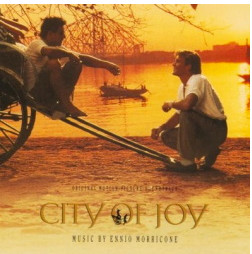主页--->m-comment-000--->mb-comment-012-124
|
电脑版 |
|||||||||||||||||||||||||||||||||||||||||||||||||||||||||||||||||||||||||||||||||
布罗克斯顿评说莫里康内 MB-012-124 |
||||||||||||||||||||||||||||||||||||||||||||||||||||||||||||||||||||||||||||||||||
CITY OF JOY – Ennio Morricone |
||||||||||||||||||||||||||||||||||||||||||||||||||||||||||||||||||||||||||||||||||
FA9201 CITY OF JOY / 欢喜城 / 欢乐之城 |
||||||||||||||||||||||||||||||||||||||||||||||||||||||||||||||||||||||||||||||||||
作者 乔纳森·布罗克斯顿 (Jonathan Broxton) |
||||||||||||||||||||||||||||||||||||||||||||||||||||||||||||||||||||||||||||||||||
ENNIO MORRICONE 评论,第12部分 012-124 |
||||||||||||||||||||||||||||||||||||||||||||||||||||||||||||||||||||||||||||||||||
 |
||||||||||||||||||||||||||||||||||||||||||||||||||||||||||||||||||||||||||||||||||
欢乐之城——埃尼奥·莫里康内 2022.5.12
倒退30年 乔纳森·布罗克斯顿(Jonathan Broxton)的原始评论 英国导演罗兰·乔菲(Roland Joffé)的职业生涯是近代电影界最奇怪的职业生涯之一。1984 年,他凭借电影《杀戮场》获得了国际评论界的赞誉和奥斯卡认可,该片讲述了 1970 年代柬埔寨残酷的红色高棉政权,随后在 1986 年拍摄了他最著名的电影《教会》。然而,在 1980 年代末和 1990 年代连续失败后,包括《胖子和小男孩》、《红字》和《再见情人》等作品,他最终沦为制作低成本的“酷刑色情”恐怖电影,如《囚禁》,现在已经超过 15 年没有拍过一部大电影了。乔菲制作的最后一部好电影可能是这部:1992 年的《欢乐之城》。它由帕特里克·斯威兹 (Patrick Swayze) 饰演一名美国医生,他在职业危机后前往印度寻求“精神启蒙”,并发现自己深入参与帮助生活在加尔各答贫民窟的人们。这部电影由宝琳·柯林斯(Pauline Collins)和奥姆·普里(Om Puri)联合主演,在评论界取得了小小的成功,但今天在很大程度上被遗忘了。 尽管这位导演的职业生涯呈螺旋式上升,但罗兰·乔菲作品的最佳遗产之一是他的电影启发了埃尼奥·莫里康内创作了一些他最伟大的电影音乐。乔菲和莫里康内一起合作了四部电影:《教会》、《胖子和小男孩》和 2000 年的《瓦岱尔》,尽管《教会》被誉为电影史上最伟大的配乐之一,但其他电影也不应被忽视。《欢乐之城》可以准确地描述为“印度的教会”——这是一首包含几个可爱的反复出现的主题的乐谱,这些主题在印度次大陆的大量传统乐器织体中呈现,包括西塔琴 (sitar )、塔布拉鼓 ( tabla drums)、坦布拉琴(tambura)和班苏里长笛( bansuri flute)等熟悉的声音,以及标准的交响乐团和歌手。这首歌在意大利和伦敦录制,以极好的标题主题“欢乐之城”开场,这是一首欢快而振奋人心的管弦乐队作品,以及断奏、吠叫的合唱,伴随着轻快的旋律,配以不寻常的短笛小号。这个主题主要代表了斯威兹的性格马克斯·洛,以及他真诚善良和无私的天性,关心加尔各答的穷人。 在《穷人家庭》中引入的第二个反复出现的主题是 Om Puri 的角色 Hazari Pal 的主题,他是一位来自印度农村地区的农民,他与家人一起搬到加尔各答寻求更好的生活,但由于无数的艰辛和不幸,他最终生活在贫民窟, 并最终与Lowe相遇。这个主题是华丽的,在某些地方令人心碎的美丽,但有一种内在的信念和坚韧的感觉,完美地概括了哈扎里的天性,以及他为了家人的利益而克服生活给他带来的任何障碍的愿望,有尊严和决心。主题是木管乐器的展示——旋律在短笛单簧管、竖笛、长笛之间梦幻般地融化,然后再回来——将吸引任何曾经喜欢莫里康内郁郁葱葱、浪漫一面的人。它不像《教会》中的任何内容那样立即狂喜——是什么?– 但它有其精致美丽的时刻。 第三个反复出现的主题是琼的主题,琼是一位善良的爱尔兰护士,她经营着加尔各答诊所,电影的大部分内容都发生在加尔各答诊所,它在名为“一夜,偶然”的两个线索中得到了最突出的表演。主题是柔和的,亲密的,但也有点忧郁,弦乐和呼吸木管乐器的美丽二重奏,带有钢琴的微弱暗示,这说明了琼的性格:坚实,可靠,不废话,但被关心他人的需要所驱使,并且具有略带渴望的品质,承认她无法拯救所有来到她的“欢乐之城”的人——免于死亡, 从疾病,从贫困,从腐败。这种温柔与厌世的现实主义相结合,非常出色,有时甚至相当感人。 与莫里康内乐谱一样,这些主题构成了乐谱的支柱,并随着乐谱的进行而多次重复和变化。例如,在“希望”中,麦克斯的主题被安排为一个由次大陆乐器组成的小型管弦乐队,以及标准合奏和一些听起来相当不寻常的键盘,以莫里康内风格的近似印度古典音乐。这种来自截然不同的种族背景的风格的融合令人着迷,莫里康内让他的旋律保持在作品的中心,同时用所有不寻常的音调和纹理装饰它的方式令人印象深刻。在其他地方,在“季风”中,主题伴随着闪闪发光的金属纹理,听起来像是雨滴的净化音调,在胡格利河中荡漾和跳舞。在另外两个线索中,还有两个对哈扎里主题的另外重要重复,也都被称为“穷人的家庭”,其中第一个以复古莫里康内为特色的精湛合唱变奏。 一两件独立作品也给人留下了深刻的印象。《For a Daughter's Dowry》的后半部分由一位男高音独唱,其人声音色与独特的键盘质感相结合,出人意料地表现出色,而《The Birth》则是崇高、温柔、平静,并带有郁郁葱葱、优雅的弦乐声。 然后,在温柔和美丽的另一面,加尔各答生活的严酷和野蛮通过几个延伸的悬念和动作音乐序列来传达,其中一些变得非常不和谐。“Crack Down”用一些喜怒无常的木管乐器写作让你慢慢放松,这实际上让我想起了 1960 年代的约翰·巴里,但后来的提示,如“在迷宫里”、“绝望的外科医生”、尖锐而坚持的“布斯蒂教父”、有时相当激烈的“加尔各答”,以及 15 分钟的序列,包括“蠕虫转弯”、“迷宫”、“迷宫”、”“和”到加尔各答“要黑暗得多,使用听起来很紧张的嘎嘎作响的打击乐想法、鲜明的管弦乐段落和其他不和谐的纹理,传达了故事中涉及小偷、无良地主、有组织罪犯等的一些令人讨厌的方面。 “For Roland”中主题的最后重演很可爱,并为 Ennio Morricone 在 1990 年代最被忽视和被低估的配乐之一提供了一个很好的尾声。看,当你拥有像埃尼奥·莫里康内那样的职业生涯,拥有如此多的标志性主题和有史以来的好成绩时,不可避免地会有如此多的工作最终被忽视。对于像《欢乐之城》这样的东西来说,这是双倍的,它在时间和风格上的接近以及与《教会》的合作内容会让任何分数相比之下都显得苍白无力——是的,它确实如此。这个事实是无法回避的。但尽管如此,如果您是莫里康内作品的粉丝,欢乐之城仍然值得探索;主题真的很可爱,一些动作和悬疑音乐很有趣,电影的地理背景让作曲家探索了一些在他的作品中不经常出现的乐器和声音,仅此一项就使它成为一个值得注意的乐谱。 从英国电影音乐商店购买《欢乐之城》原声带 曲目列表:
片长:58分41秒 史诗唱片 EK-52750 (1992) 音乐由埃尼奥·莫里康内(Ennio Morricone)作曲和指挥。埃尼奥·莫里康内(Ennio Morricone)的编排。由 Franco Patrignani 和 Dick Lewzey 录制和混音。由Joe Illing编辑。专辑由Ennio Morricone和Enrico de Melis制作 |
||||||||||||||||||||||||||||||||||||||||||||||||||||||||||||||||||||||||||||||||||
2022.5.12 |
||||||||||||||||||||||||||||||||||||||||||||||||||||||||||||||||||||||||||||||||||
|
| ||||||||||||||||||||||||||||||||||||||||||||||||||||||||||||||||||||||||||||||||||
以下是原文
| ||||||||||||||||||||||||||||||||||||||||||||||||||||||||||||||||||||||||||||||||||
ENNIO MORRICONE REVIEWS, Part 12-124 |
||||||||||||||||||||||||||||||||||||||||||||||||||||||||||||||||||||||||||||||||||
CITY OF JOY – Ennio MorriconeMay 12, 2022
THROWBACK THIRTY Original Review by Jonathan Broxton The career of British director Roland Joffé is one of the oddest ones in recent cinema; after cutting his teeth making gritty UK TV dramas he gained international critical acclaim and Oscar recognition in 1984 for his film The Killing Fields, about the brutal Khmer Rouge regime in Cambodia in the 1970s, and followed that with what is probably his most famous film, The Mission, in 1986. However, after making several consecutive flops in the late 1980s and 1990s, including things like Fat Man and Little Boy, The Scarlet Letter, and Goodbye Lover, he was eventually reduced to making low-budget ‘torture porn’ horror movies like Captivity, and now hasn’t made a major movie in more than 15 years. Possibly the last good movie Joffé made was this one: City of Joy, from 1992. It stars Patrick Swayze as an American doctor who travels to India in search of ‘spiritual enlightenment’ after a career crisis, and finds himself becoming deeply involved with helping people who live in the slums of Calcutta. The film co-stars Pauline Collins and Om Puri, and was a minor critical success, but is largely forgotten today. Despite the director’s own spiraling career, one of the best legacies of Roland Joffé’s work is that his films inspired Ennio Morricone to write some of his greatest film music. Joffé and Morricone worked on four films together: The Mission, Fat Man and Little Boy, this one, and Vatel in 2000, and although The Mission is rightly lauded as one of the greatest scores in the history of cinema, the others should not be overlooked either. City of Joy could probably be accurately described as ‘The Mission in India’ – it’s a score that contains several lovely recurring themes, which are presented amid a whole host of traditional instrumental textures from the Indian subcontinent, including such familiar sounds as a sitar, tabla drums, a tambura, and a bansuri flute, along with a standard symphony orchestra and vocalists. It was recorded in both Italy and London and opens with the superb title theme “City of Joy,” an upbeat and rousing piece for orchestra and a staccato, barking chorus with a buoyant recurring melody backed by the unusual-sounding piccolo trumpet. This theme mostly represents Swayze’s character Max Lowe, and his genuinely good-hearted and altruistic nature, caring for the poor of Calcutta. The second recurring theme, introduced in “The Family of the Poor,” is the theme for Om Puri’s character Hazari Pal, a farmer from a rural part of India who moves to Calcutta with his family in search of a better life but who, as a result of numerous hardships and instances of ill-fortune, ends up living in the slums, and eventually crosses paths with Lowe. This theme is gorgeous, heartbreakingly beautiful in places, but with a sense of inner conviction and fortitude that perfectly encapsulates Hazari’s nature, and his desire to overcome whatever obstacles life throws at him for the benefit of his family, with dignity and resolve. The theme is a showcase for woodwinds – the melody melts dreamily between a piccolo clarinet, a recorder, a flute, and back again – and will appeal to anyone who has ever loved Morricone’s lush, romantic side. It’s not as immediately rapturous as anything in The Mission -what is? – but it has its moments of delicate beauty. The third recurring theme is the theme for Joan, the kind-hearted Irish nurse who runs the Calcutta clinic within which much of the film takes place, and it gets its most prominent performances in the two cues called “One Night, By Chance.” The theme is soft, intimate, but also a little melancholy, a beautiful duet for strings and breathy woodwinds with the merest hint of a piano, and which speaks to Joan’s character: solid, dependable, non-nonsense but driven by the need to care for others, and with a slightly wistful quality that acknowledges the fact that she cannot save everyone who comes to her ‘city of joy’ – from death, from disease, from poverty, from corruption. This tenderness combined with world-weary realism is excellent, and at times quite moving. As is often the case with Morricone scores, these themes form the backbone of the score, and receive several reprises and variations as it progresses. For example, in “Hope,” the theme for Max is arranged for a small orchestra of sub-continental instruments alongside the standard ensemble and some rather unusual-sounding keyboards, in a Morricone-style approximation of Indian classical music. This blending of styles from vastly different ethnic backgrounds is fascinating, and the way Morricone allows his melody to remain central to the piece while adorning it with all the unusual tones and textures is very impressive. Elsewhere, in “Monsoon,” the theme is accompanied by sparkling, shimmering metallic textures that sound like the cleansing tones of raindrops, rippling and dancing into the Hooghly river. There are also two additional significant reprises of Hazari’s theme in two further cues, both also called “The Family of the Poor,” the first of which features a superb choral variation that is vintage Morricone. One or two standalone pieces also impress. The second half of “For a Daughter’s Dowry” features an unexpectedly excellent performance by a solo boy soprano whose vocal timbre combines with idiosyncratic-sounding keyboard textures, while “The Birth” is just sublime, gentle and peaceful and with a lush, elegant sweep to the strings. Then, on the flip side of the tenderness and beauty, the harshness and brutalism of life in Calcutta is conveyed with several extended sequences of suspense and action music, some of which gets quite dissonant. “Crack Down” eases you in slowly with some moody woodwind writing that actually reminds me a little of 1960s John Barry, but then later cues like “In the Labyrinth,” “A Surgeon in Despair,” the shrill and insistent “Godfather of the Bustee,” the sometimes quite intense “Calcutta,” and the 15-minute sequence comprising “The Worm Turns,” “The Labyrinth,” and “To Calcutta” are much darker, using nervous-sounding rattling percussion ideas, stark orchestral passages, and other dissonant textures, to convey some of the unsavory aspects of the story involving thieves, unscrupulous landlords, organized criminals, and more. The final reprise of the main theme in “For Roland” is lovely, and provides a nice coda for what is one of Ennio Morricone’s most overlooked and underrated scores of the 1990s. Look, when you have the type of career that Ennio Morricone had, with so many iconic themes and all-time great scores under your belt, it’s inevitable that so much work ends up flying under the radar. This goes double for something like City of Joy, whose closeness in time and style and collaborative content to The Mission would make any score pale in comparison – and, yes, it does. There’s no getting around that fact. But despite that, City of Joy is still well worth exploring if you’re a fan of Morricone’s work; the main themes are genuinely lovely, some of the action and suspense music is interesting, and the film’s geographic setting gave the composer to explore some instruments and sounds that didn’t often feature in his work, and that alone makes it a score of note. Buy the City of Joy soundtrack from the Movie Music UK Store Track Listing:
Running Time: 58 minutes 41 seconds Epic Records EK-52750 (1992) Music composed and conducted by Ennio Morricone. Orchestrations by Ennio Morricone. Recorded and mixed by Franco Patrignani and Dick Lewzey. Edited by Joe Illing. Album produced by Ennio Morricone and Enrico de Melis. |
||||||||||||||||||||||||||||||||||||||||||||||||||||||||||||||||||||||||||||||||||
May 12, 2022 |
||||||||||||||||||||||||||||||||||||||||||||||||||||||||||||||||||||||||||||||||||
本站电影欣赏 |
||||||||||||||||||||||||||||||||||||||||||||||||||||||||||||||||||||||||||||||||||
在线音乐试听 |
||||||||||||||||||||||||||||||||||||||||||||||||||||||||||||||||||||||||||||||||||
|
||||||||||||||||||||||||||||||||||||||||||||||||||||||||||||||||||||||||||||||||||
 |
||||||||||||||||||||||||||||||||||||||||||||||||||||||||||||||||||||||||||||||||||
Jon 是一位电影音乐评论家和记者,自 1997 年以来一直担任全球最受欢迎的英语电影音乐网站之一 Movie Music UK 的编辑和首席评论员,并且是国际电影音乐评论家协会 (IFMCA) 的主席。在过去的 20多 年中,Jon 撰写了 3,000 多篇评论和文章,并进行了多次作曲家采访。在杂志刊物方面,乔恩曾为《电影配乐月刊》、《原声带杂志》和《电影音乐》等出版物撰写评论和文章,并为普罗米修斯唱片公司的两张经典 Basil Poledouris 配乐专辑《Amanda》和《Flyers / Fire on the Mountain》撰写了衬垫注释。他还为汤姆·胡佛 (Tom Hoover) 于 2011 年出版的《Soundtrack Nation: Interviews with Today's Top Professionals in Film, Videogame, and Television Scorering》一书撰写了一章。在1990年代后期,乔恩是伦敦皇家爱乐乐团的电影音乐顾问,并与他们合作拍摄了约翰·德布尼(John Debney)的音乐电影《相对价值》(Relative Values)和奥利弗·海斯(Oliver Heise)的音乐《佛陀的指环》(The Ring of the Buddha),以及与兰迪·纽曼(Randy Newman)合作的一系列音乐会。2012年,乔恩在波兰克拉科夫举行的第五届年度电影音乐节上担任“电影节学院”主席。他是作曲家和作词家协会的成员,该协会是作曲家、作词家和词曲作者从事电影、电视和多媒体工作的首要非营利组织。 |
||||||||||||||||||||||||||||||||||||||||||||||||||||||||||||||||||||||||||||||||||
2023.12.20 |
||||||||||||||||||||||||||||||||||||||||||||||||||||||||||||||||||||||||||||||||||
2023 手机版 |
||||||||||||||||||||||||||||||||||||||||||||||||||||||||||||||||||||||||||||||||||
|
||||||||||||||||||||||||||||||||||||||||||||||||||||||||||||||||||||||||||||||||||













